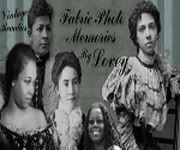Ever heard of the famous seven Sutherland Sisters and their “Niagara of Curls”? Why were the seven Sutherland sisters such a popular attraction for the Barnum and Bailey Circus? It wasn't for their singing, it was for their tresses - a collective total of 36 1/2 feet of hair.
From the left: Sarah, Naomi, their father Fletcher, Grace, Victoria, Dora, Mary, and Isabella.
The Sutherland sisters were born into extreme poverty between the years 1845 and 1862 in Cambria, New York.
As a means of pulling his family out of poverty, their father, Reverend
Fletcher Sutherland, tried to get them into theatres as singers. But it
wasn't their parlor songs and ballads that gained them fame, it was
their hair. The grand finale of their act was when they turned their
backs to the audience and their father shouted: "Let down your hair."
But how did their hair come to grow so long, the public wondered? A
rumor circulated stating that their mother had applied some form of
concoction to enhance the growth.
Whether that was true or not, their father soon created a special tonic
made from 56% witch-hazel water, 44% rum, salt, magnesium, and
hydrochloric acid, and marketed it. With the seven sisters used a proof
the product works, and the fact that their father was a respected
preacher, the product was highly successful and the family suddenly
found themselves comfortable wealthy. From tonics, the company expanded
into numerous other lotions and cosmetics.
Grace Sutherland (1854-1946).
Tenor and piano accompanist.
The fourth sister, Grace, lived the longest and ran the family business.
Grace had a 5 to 6-long, auburn mane.
She was considered to be chatty and a great communicator with a sly
smile.
She managed most of the sisters business and personal
correspondence.
Grace was committed to the Erie County Home
on
December 14, 1945 where she died on January 13, 1946, unmarried and
destitute at age 92.
There was no room for her in the Castlemaine
mausoleum
(where her sisters were buried) so she was
buried in an
unmarked grave
in Glenwood Cemetery, Lockport, Niagara Co., New York.
Naomi Sutherland (1858-1893).
Bass vocalist.
Naomi, the fifth sister, had the thickest hair, which could envelop her whole body.
She had three children with Harry Bailey.
Naomi was the "busty one" and known for her 5 and 1/2 feet long, thick
curly hair.
She had the same sly smile as sister Grace and a Roman nose.
She was one the most distinctively talented female singers
of the turn
of the century, with a deep bass voice
"that brought the men to their
knees," a newspaper noted.
As the Sutherland business
prospered, Naomi and Grace
proved to be among the family's best
saleswomen,
as in touch with the desires of their parlor clientele as
they were with
the demands of their big concert audiences.
Naomi was the
most loyal and matronly of the seven.
She married showman
Harry Bailey (born Joseph Henry),
a relative of circus magnate James A.
Bailey, in March of 1885.
Their son Henry was born in October 1885,
followed by Fletcher in 1887 and Isabelle (Naomi) in 1890.
Naomi seemed
made for motherhood and almost too good for this world.
She died at home
in 1893 at the age of 35, after a short illness.
Naomi's husband
founded the Sutherland Sisters Corporation
and applied for the company’s
first trademark in 1883,
for the Seven Sutherland Sisters Hair Grower.
Isabella Sutherland (1852-1914)
High soprano.
Isabella,
the third sister, had dark eyes like her younger brother,
the baritone
Charles Sutherland.
Apart from her 6-foot-long flowing, frizzy black
hair
she did not resemble her sisters. Some believe she is actually a
first cousin.
She had thin facial features and a lean body
with
disappearing lips and a worried brow.
Isabella was also a poet and dreamer who tragically
lost heart and her faith.
She had a tendency to cling to untamable men.
Nonetheless when Frederick Castlemaine, a French nobleman
came around
to court younger sister Dora, he ended up marrying Isabella,
who was
more than 10 years his senior.
Isabella married twice in her life and ultimately
betrayed her sisters at the height of Sutherland prosperity.
She died at age 62.
Sarah Sutherland (1845-1919).
High soprano.
Sarah was the first sister.
She managed the group's singing and dancing acts in
the various theatres and was the President of their company.
Sarah had the shortest hair of the sisters at only 3 feet long,
but it
was thick and wavy. When the sisters posed for photo shoots,
Sarah would
sit and others would bend their waists so
that it seemed that all seven
had hair that brushed the ground.
A leather-covered Bible was always
with Sarah and she
used her talents as a high solo soprano
and pianist
to become a revered music teacher.
Sarah never married and
when she died in 1919, aged 74,
her family kept her body on display in
the home,
and resisted burying her until forced to by local authorities.
Mary Sutherland (1862-1939).
Soprano.
Mary, the seventh sister,
suffered from mental problems her entire life.
Her smoky moon face, deep eyes and full lips were remarkable,
but the
family felt, Mary was sometimes best understood
from a distance—her
stage talent was fleeting,
singing unreliable, and numerous tantrums
baffling.
She had 6-foot-long hair, was thought to be mentally
ill
(possibly bi-polar) and would have "spells" during which
she was
locked in her bedroom. Her behavior was a
closely-guarded secret, as
long, heavy hair was thought by
some to "rob the brain of nourishment"
and lead
to insanity (not great for marketing the hair tonic).
She ended up being committed to Buffalo State
Asylum for the Insane, where she died in 1939.
Dora Sutherland (1858-1919)
Alto.
Dora, the sixth sister, was always referred to as "the cute one"
in her Broadway and circus days. She maintained 4 1/2 to 6 foot-
long hair over the years. Her face was considered dreamy, like
a nineteenth century pin-up, with a turned up nose and a
sentimental pout that could melt any heart.
Dora was an alto in the group's singing act. She had a sharp mind
that helped her succeed as an incorrigible flirt and, later, to set
herself apart as a smart businesswoman as an entrepreneur in
the Canadian territories.
She was hit and killed by a car while crossing the street
in Los Angeles, aged 61 years.

Victorian Sutherland (1849-1902)
Mezzo-Soprano.
Victoria, the second of the girls, had the longest hair of them
all, a full seven long from the top of her head to the ends.
When she let it down, it would drag on the ground behind her.
One fan offered Victorian $2500 to cut off all her hair
but she refused. But she did sell one strand of hair to a jeweler
for $25. The jeweler then suspended a seven carat diamond from
it and hung it in his shop window.
Victoria was always considered a beauty. In 1989, she married
Wesley Craw, a 19 year old when she was 49. Her sisters
were outraged and kicked her out of the family mansion.
She was ostracized from them for the rest of her short life.
She passed away in New York City
in her home in 1902 at age 53.
Not surprisingly, the meteoric rise to fame and riches made a deep
impact on the family, which grew increasingly eccentric as the
once-impoverished sisters reveled in their lavish wealth. In 1893, the
seven, now world-famous, returned home determined to live together,
erecting a tremendous mansion in rural Cambria, New York, where their
family’s log cabin once stood. The 14-room dream home—which also became
the headquarters of their business—looked something like a princess’s
castle with a turret, cupola, and veranda. Inside, the family and their
guests luxuriated with all-hardwood floors under their feet, heavy
crystal chandeliers overhead, and black walnut woodwork all around them.
The opulent estate featured the first indoor bathroom in Cambria, a
marble beauty with hot and cold running water, as well as beds imported
from Europe. Even the servants had posh, well-appointed rooms in the
attic.
Writing in the April 1982 edition of
Yankee magazine, Dianne
L. Sammarco and Kathleen L. Rounds explain that “Pets were treated like
royalty, with winter and summer wardrobes, and grand funerals and
obituaries in the local newspapers. The carriage horses were shod in
gold. The sisters sponsored many a gala social for the neighbors, often
including fireworks.” To maintain their impressive running-water system,
a servant had to fill a tank in the attic with water every day.
Using loose strands that came out when their hair was brushed, the sisters had seven 3-feet-tall mannequin dolls made in their image, according to Long Hair Lovers Blog.
Dressed in the best Victorian fineries, the dolls would be sent to
stores to advertise Seven Sutherland Sisters products in the store
windows, but were always returned to the manse, in the charge of the
women’s seven personal maids, who were also paid to comb and detangle
the sisters’ flowing locks every night.

An American drugstore advertising the
hair products of the 7 Sutherland sisters, 1889.
Even though they were raking in millions at the turn of the century, the women’s spending on such extravagances—servants, clothes, fine jewelry,
seconds homes, globe-trotting, booze, and lovers—was out of control.
Outwardly, they maintained the appearances of proper, educated
Christians, but behind closed doors, they engaged in love triangles,
in-fighting, drug use, and bad financial investments. Their antics and
wild, over-the-top parties were the talk of Niagara County, as people
speculated about whether they were polyamorous or practicing
spiritualism or witchcraft.
The final death knell to the Sutherlands’ prosperity came in the 1910s: Rebellious young women, known as flappers,
started to chop their hair into startlingly short bobs. As the trend
grew more mainstream, the appeal of the Seven Sutherland Sisters Hair
Grower plunged. Isabella died in 1914, and the family fortune was
slipping away fast. The last three women headed to Los Angeles in 1919
in a desperate attempt to pitch their story to Hollywood, but they deal
went sour and Dora was killed in a car crash during their trip. Mary and
Grace were so broke at that point, they didn’t even have the money to
get her cremated, so they never claimed her remains.
By 1920, these two were the only living sisters, and they attempted
to keep their “hair fertilizer” business alive in an era that no longer
loved ridiculously long locks. Hardly able to buy food, they had to
abandon their mansion in 1931. Great Jazz Age cartoonist John Held, Jr.,
gently mocked them as “Dream Girls of a Dim Decade.”
By
1936, the Seven Sutherland Sisters went out of business for good. The
empty estate caught on fire and burned to the ground on January 24,
1938, and endless numbers of Seven Sutherland Sisters
documents—including, possibly, the patent tonic recipes—and artifacts
went up in smoke. Mary ended up committed to Buffalo State Asylum for
the Insane, where she died in 1939. Grace died destitute at age 92 in
1946, and as there was no room for her in the Castlemaine mausoleum, she
was buried in an unmarked grave.
And so the seven headline-stealing wonders of the Victorian era
faded into obscurity. Perhaps we can rest assured that some of today's pop princesses and their twerking shenanigans will disappear deep into the pages of
pop-culture history in much the same way. One can always hope.
Be sure to check out the other participants today at Beverly's Pink Saturday Blog Hop!
Now, go make something beautiful!
´¨)
¸.•´¸.•*´¨) ¸.•*´¨)
(¸.•´ (¸.•´? Tristan
Giving the guys their fair share of time.
Meet the House of David Baseball Team, 1902.
Famous for their athletic prowess, muscular bodies, handsome
faces and long, luxurious hair, these fellows were the Victorian
summertime stars of their day!
More about them in another post!





























































































































































